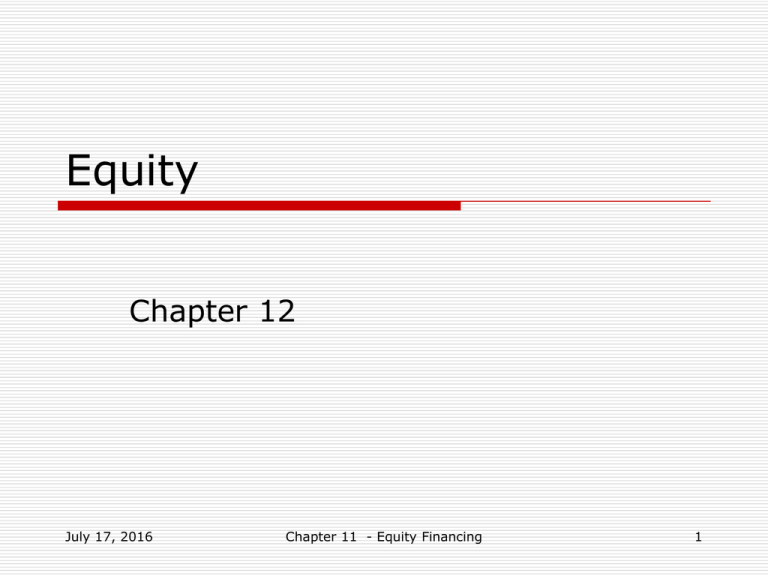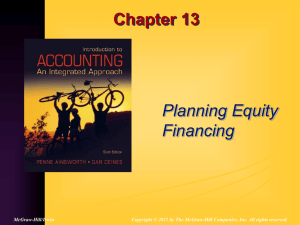Equity Chapter 12 July 17, 2016 1
advertisement

Equity Chapter 12 July 17, 2016 Chapter 11 - Equity Financing 1 Crosslisting reduce information asymmetry increases share price lower WACC improve liquidity larger primary market larger secondary market hedge operating risk denominate both assets and liabilities in terms of the same currency July 17, 2016 Chapter 11 - Equity Financing 2 Depository receipts negotiable certificates issued by foreign bank backed by underlying security traded in secondary markets representing a multiple of underlying shares traded in & dividends paid in foreign currency terms DRs traded in accordance with foreign securities regulations sponsored (firm)- unsponsored (investor) July 17, 2016 Chapter 11 - Equity Financing 3 Cross listing Listing shares on different country exchanges Purpose of crosslisting Improving liquidity More potential investors International recognizability Eliminate mispricing (underpricing) Establish secondary market shares offered for foreign acquisitions July 17, 2016 Chapter 11 - Equity Financing 4 Relative market liquidity Value of trades in the year 2002 NYSE NASDAQ LSE Euronext Tokyo Deutsche Spain Italy Swiss Taiwan Korea July 17, 2016 $10,311,156,000,000 (2,366) $7,254,594,000,000 (3,649) $4,001,340,000,000 (2,274) $1,988,359,000,000 (1,114) $1,564,244,000,000 (2,154) $1,212,302,000,000 (934) $653,229,000,000 (1,015) $634,635,000,000 (295 $599,749,000,000 (398) $633,632,000,000 (641) $596,632,000,000 (679) Chapter 11 - Equity Financing 5 Empirical evidence share price reaction to crosslisting negative effects to US firms listing in continental Europe positive effects to US firms listing in London, Tokyo, Toronto positive effects for foreign firms listing in the US the larger a firm relative to its domestic market, the more likely it was to crosslist elsewhere July 17, 2016 Chapter 11 - Equity Financing 6 Barriers to crosslisting disclosure requirements vary with markets rules in N. America informationally onerous expensive feed information to market rules elsewhere less stringent reporting less frequent lower disclosure requirements July 17, 2016 Chapter 11 - Equity Financing 7 The New York Stock exchange specialists trade on floor hold positions for liquidity transaction costs (spread) function of volume function of volatility limit orders take precedence over dealer orders July 17, 2016 Chapter 11 - Equity Financing 8 Other exchanges London exchange less liquid higher transaction costs limit orders not executed chronologically lower regulatory costs more foreign firms listing Tokyo exchange substantially lower overall exchange market July 17, 2016 Chapter 11 - Equity Financing 9 International equity directed shares targeting financing from target foreign market private placements euro-equity issues equity sold in countries different than their origin tranches - large stock blocks sold to underwriters underwritten and distributed in multiple July 17, 2016 Chapter 11 - Equity Financing 10 capital markets Directed public share issues Float a new issue in a foreign country May be needed to finance An acquisition of existing production facilities New production facilities Complete foreign underwritten and floated July 17, 2016 Chapter 11 - Equity Financing 11 Strategic alliances take advantage economies of scale and scope marketing joint marketing and sales Air Canada, United Airlines financing seeking to lower WACC development Airbus July 17, 2016 Chapter 11 - Equity Financing 12 Privatizations selling government owned enterprises Western Europe Eastern Europe political will employment programs profitability market forces versus political forces July 17, 2016 Chapter 11 - Equity Financing 13



